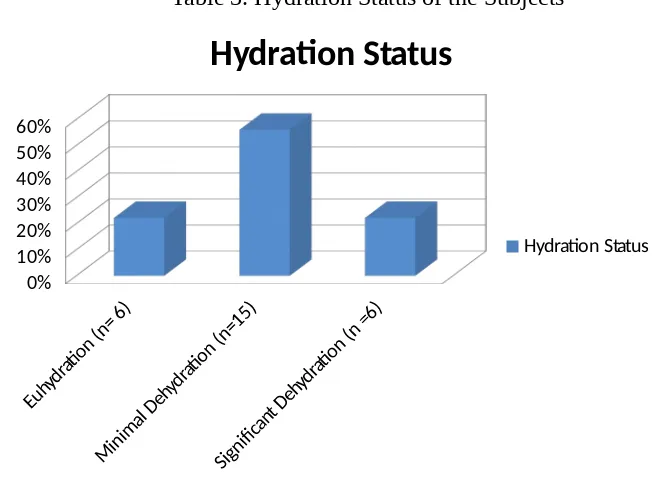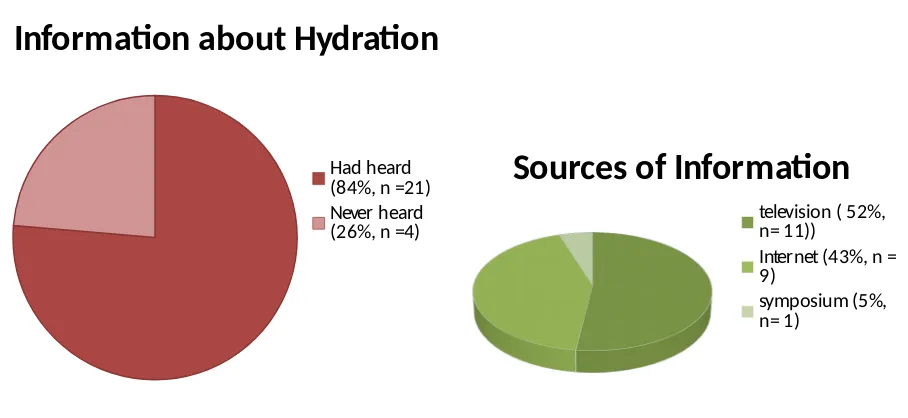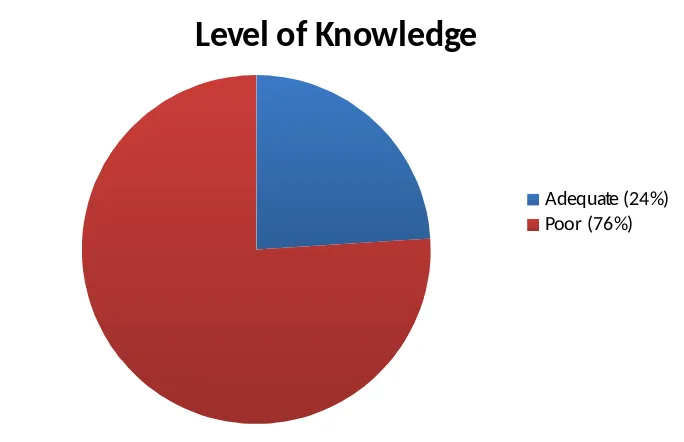Sports Hydration Study in Indonesian Recreational Futsal Players
Muhammad Ikhwan Zein1Saryono2
1Sports Coaching Departement, Faculty of Sports Science, Universitas Negeri Yogyakarta 2Physical Education Departement, Faculty of Sports Science, Universitas Negeri Yogyakarta
Background
Futsal is a popular sport in Indonesia. This sport is played by a lot of people, particularly students and college students as recreational physical activity. Youths do not regard futsal as a hobby any longer. Futsal has become a trend and lifestyle (Bancin, 2009)
Hydration is one of the most important things to be considered when youths exercising. This is crucial as their previous activities can potentially cause their bodies experiencing lack of fluid/dehydration, specifically futsal is a high-intensity exercise that results in great amount of sweat. Dehydration results in a decrease in performance and health problems.
This study was conducted to determine hydration status of recreational futsal players before they exercise and to evaluate their level of knowledge on the fulfillment of body fluid in sports.
Objectives
Determining the hydration status of futsal players before start exercising.
Evaluating the knowledge of recreational futsal players about hydration and fulfillment of body fluid during exercise.
Assessing the relationship between knowledge and hydration status of recreational futsal players just before they start exercising.
Methods
Design
This research was performed using cross sectional design and analytic descriptive.
Inclusion criteria:
1. Male futsal player 17-25 y.o. 2. College student
3. A member of futsal community or team 4. Exercising for recreational or fitness purposes 5. Playing futsal routinely at least once a week.
Exclusion Criteria:
1. A member of professional futsal club
2. Listed as a member of university futsal team that plays in college competition.
3. Not involved in a comprehensive research series, including health assessment, questionnaire completion, hydration status check.
Working Procedure
The subject was selected from futsal team members who met the criteria and agreed to cooperate using purposive/judgmental sampling method. The study was conducted in a commercial futsal court in Yogyakarta, Indonesia.
Medical Screening and Informed Consent
Health assessment was conducted to ensure the subject did not have health problems that would be a risk when playing futsal, and it was also important to ensure that the subject did not consume substances or drugs that affect the specific gravity of urine, such as diuretics for medical reasons. Subject who agreed to participate in the study signed an informed consent sheet as a sign of approval.
Baseline Characteristics
The early stages of data collection were performed by measuring and recording the basic data, such as name, date of birth, age, address, phone number, height, and weight.
Specific gravity of subject’s urine was measured using a urine test stick before playing futsal (+ 10 minutes). Measurements were performed by collecting subject’s urine and dipping a urine test stick. Color change that occurred on a stick would be compared with a standard to determine specific gravity of urine. The subject 's hydration status was determined based on the results of these measurements, the reference value as follows :
Table 1. Reference value of Urine Specific Gravity (Casa DJ et al, 2000)
Urine Specific Gravity Hidration Status
Euhidration < 1.010
Minimal Dehidration 1.010 – 1.020
Significant Dehidration 1.021 – 1.030
Hidration Study Questionnairre
Subject who had undergone urine specific gravity measurements was asked to fill out questionnaires about hydration. This questionnaire has been tested and validated on the same population before the study was conducted.
This questionnaire was compiled to determine the level of knowledge of the subject about fulfillment of body fluid in sports that included:
a) Knowledge of hydration and its benefits b) Knowledge of dehydration and its risks
c) Knowledge of recommendation/suggestion on fulfillment of fluid in sports, either before, during, and after exercise.
Results
Subjects Characteristics
A total of 27 subjects participated in this study have the following characteristics:
Table 2. Characteristics of the Subjects
Characteristics Subjects (n = 27)
Age (years) 22 + 3.19
Weight (kg) 22 + 3.19
Height (m) 1.69 + 0.08
Hydration Status
Measurement of urine stick test results showed that as many as 22.2 % (n = 6) subjects had a good hydration status/euhidrasi and 77.7 % (n = 21) experienced dehydration before playing futsal. A total of 15 out of 21 dehydrated subjects experienced minimal dehydration and the remaining 6 subjects experienced significant dehydration.
Table 3. Hydration Status of the Subjects
0% 10% 20% 30% 40% 50% 60%
Hydration Status
Hydration Status
Hydration Study Questionnaire
A total of 27 subjects completed questionnaires after urine test pack test was conducted. Data analysis was performed on 25 questionnaires because 2 questionnaire forms were not completed and were excluded from this study. Results of the questionnaire showed that 21 subjects had heard information about hydration and as many as 4 subjects did not recognize about hydration. The majority of subjects obtained information through television (n = 11), internet (n = 9), and seminars or symposium (n = 1) .
Information about Hydration
Had heard (84%, n =21) Never heard (26%, n =4)
Sources of Information
television ( 52%, n= 11))
Internet (43%, n = 9)
symposium (5%, n= 1)
The level of knowledge about the fulfillment of body fluid in sports was assessed through scoring on their answers. The questions were suggestions about fluid intake before, during, and after exercise. Based on this assessment, there was no subject that had GOOD knowledge about fulfillment of body fluid. A total of 19 subjects (76 %) had POOR knowledge and the remaining 6 subjects ( 24 % ) had a level of ADEQUATE knowledge.
Level of Knowledge
Adequate (24%) Poor (76%)
Relationship between Hydration Status and Level of Knowledge about Hydration of the Subjects Kolmogorov - Smirnov hypothesis test was performed to evaluate the relationship between the hydration status of subjects before playing futsal (euhydration, minimal dehydration, and significant dehydration) with the level of knowledge of the subjects about fulfillment of fluid in sports (e.g. adequate knowledge level and poor knowledge level).
Kolmogorov - Smirnov test was performed because the samples tested did not qualify for the Chi - Square test. The test results showed no significant difference between the hydration status of futsal players before the game and the level of knowledge about hydration ( p = 0.448 ).
Table 6. Relationship between Hydration Status and Level of Knowledge of the Subjects
Euhidrasi Minimal
Dehidration
Significant Dehidration
Total (n = 25)
Low 5 14 3 22
Moderate 0 1 2 3
Total 5 15 5 25
Kolmogorov-Smirnov test, p = 0.448
The results showed that the majority of recreational futsal players in Yogyakarta suffered from dehydration ( 77.7 % ) before playing futsal, either minimal or significant dehydration. Futsal is a sport with a high intensity where energy is used predominantly through anaerobic system that can potentially cause a lot of loss of body fluids, particularly when exercising under dehydration condition. Garcia Jimenez et al (2014) showed that the average loss of fluid through perspiration experienced by professional futsal players ranging from 1700 to 2500 ml depending on the position of the player. The average loss of fluid on recreational futsal players is likely to be less than that of professional futsal players.
Body fluid is needed to keep the body temperature of a person. In the event of an increase in temperature above normal, the body must remove or dissipate heat into the environment so that the temperature remains within normal limit because heat can harm and may lead to fatal consequences (Foss, 1998). In strenuous or high intensity sports, such as futsal, basal metabolic rate of the player increases 20 -25 times that resulted in body temperature increase 0.1o C every 5 minutes (Murray & Udermann, 2003). On one hand, transpiration is one of the mechanisms of the body to dissipate heat. But, on the other hand, it will also reduce fluid and electrolyte in the body. Thus, if they are not replaced, one will experience dehydration. Dehydration experienced by recreational futsal players can cause health problems ranging from muscle cramps to heat exhaustion. Loss of body fluid more than 2 % also decreases cognitive functions such as perception and reaction time so that the risk of injuries will be greater (Sawka et al, 2007)
Questionnaire results showed that the level of knowledge of recreational futsal players to meet the needs of body fluid in sports was still inadequate. This is proven from the absence of subjects who were able to answer correctly about the recommendation for rehydration. It is crucial to provide good educational effort to improve their knowledge in this matter thus it is expected to encourage a positive attitude and to change their perception toward rehydration according to recommendations.
CONCLUSION
This research is the first study to determine hydration status and knowledge about hydration fluid in recreational futsal players in Yogyakarta, Indonesia. The results of this study showed that efforts should be made to increase the level of knowledge of recreational futsal players about the importance of fluid fulfillment in sports. Educational media that is appropriate to the situation and conditions in this population needs to be developed so that the message can be received well.
REFERENCES
1. Bancin Z. 2009. Futsal suatu trend dan bentuk komunitas anak muda kota Medan. Thesis in Departement of Anthropology Faculty of Social and Politic Science, Universitas Sumatra Utara.
2. Casa DJ, et al. 2000. National Athletic Trainers Association Position Stand. Fluid Replacement for Athlete. Journal of Athletic Training, 35(2):212-224.
3. Foss ML, Keteyien SJ. 1998. FOX’s Physiological Basis for Exercise and Sport. 6th ed. Boston : WCB/McGraw-Hill.
4. Murray RS & Udermann EB. 2003. Fluid Replacement : a Historical Perspective and Critial Review. International Sports Journal 7 (2) : 58-64.
5. Garcia Jimenez JV, Yuste JL, Pellicer G. 2014 Hydration Habits of Elite Field Futsal Players during Official Matches : Defenders and Forwards. AJSSM 2(3) : 88-92.



